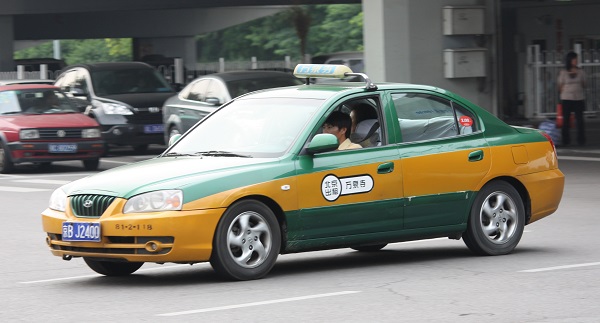
China is a huge country with a large tourism industry. Traveling around the cities and the country can be daunting if you don’t speak Chinese, but you shouldn’t let that stop you. Chinese taxis are easy to use and almost always the fastest way to get around.
Taxis are easily distinguished from other cars in China because they are a bright yellow, red, or green with a, usually, white cloth interior displaying an LED flag in the front windshield. If the flag is lit up, that means it is open and available to be used. If the flag is dark, that means the taxi is in use.
Taxis use meters, and the pricing is dependent on time and distance. If a driver tries to haggle a price and doesn’t want to use the meter, get out because that is illegal (and most likely they are trying to scam you). Taxi rates are set by local authorities and can have a starting price between 5 and 13 RMB. Like in most places, cash is the easiest way to pay for taxis. Make sure to carry smaller bills because most drivers do not accept or break bills over 100 RMB. Most taxis in China also accept credit cards if you happen to have no cash on hand.
Chinese people get in the front seat with the driver, so tourists can do that too. The drivers’ side doors will usually be locked because drivers expect passengers to enter on the passenger side of the car. Conversation is not expected, but ni hao or “nee-how” makes a great impression. Tipping is not the custom in China, and it may even confuse drivers. After paying, wait for a receipt.
Chinese is a difficult language to learn, but you don’t need to speak it to use taxis in China. Drivers are used to tourists and are familiar with the city they work in. Hotel lobbies have cards with the hotel name and address printed in Chinese; make sure to pick one up before you leave. Hotel employees are happy to help you write down the address of the location you are heading to, so you can show that to the driver, who will get you to where you are going. When entering a taxi, hand the driver the card with the name and or address written in Chinese characters. Getting around is as simple as that.
The biggest challenge to using taxis in China isn’t the language, it’s finding an available taxi because they are usually in such high demand. Rush hour is the worst time to try and hail a taxi and you may have to wait quite some time until you find one that is available. Hotels will be happy to help you hail a taxi. If you’re standing on the street, it can take some patience to hail a taxi, but you will get one.
Foreign tourists may find the Chinese taxi system daunting, but you shouldn’t. It’s a fast, easy, and affordable way to see the sights and familiarize yourself with the city.
